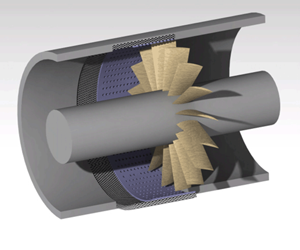Article contents
On the flow-acoustic coupling of fan blades with over-the-rotor liner
Published online by Cambridge University Press: 11 May 2022
Abstract

Over-the-rotor liner exhibits the potential to further attenuate turbofan noise, but the physics involved remain to be explored. In this paper, a three-dimensional coupled singularity method is proposed to investigate the flow-acoustic coupling effects of axially overlapping annular rotor and finite-length liner in subsonic flow. The formulation adopts the orthogonal basis expansion of the generated disturbances in terms of the hard-walled duct modes. The sound scatterings at the rotor and the liner are then characterized, respectively, by the underdetermined dipole and monopole distributions. We derive a simultaneous solution to the coupled unsteady rotor and liner responses, which ensures that the resultant perturbed field satisfies both the impermeable boundary condition on the blade surfaces and the impedance boundary condition on the lined wall. The effect of a perforated porous-material liner on the wake–rotor interaction tones is investigated. The analysis reveals that for the sound field of varying mode and frequency characteristics, moving the inlet liner to the over-the-rotor location generally leads to limited loss or even an increase of upstream sound absorption, along with additional acoustic benefits in the aft duct. The flow-acoustic coupling between the axially overlapping rotor and liner is shown to alleviate significantly the unsteady blade loading and meanwhile intensify the fluid particle oscillation through the acoustically treated wall. Sound source reduction and sound dissipation enhancement are thus identified as the governing noise attenuation mechanisms. Finally, we extend the analysis to provide insights into the effectiveness of over-the-rotor acoustic treatment with shortened axial length.
JFM classification
- Type
- JFM Papers
- Information
- Copyright
- © The Author(s), 2022. Published by Cambridge University Press
References
REFERENCES
- 9
- Cited by



